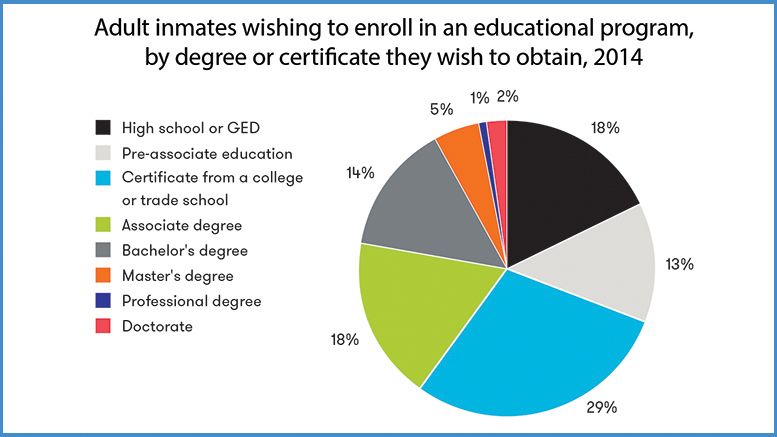Lifting the ban on Pell grants for people in prison would not only help people attain job skills and economic sustainability, it would also benefit employers, states and communities, according to a new study by the Vera Institute of Justice and the Georgetown Center on Poverty and Inequality.
The study says allowing Pell grants for prisoners would:
- Increase employment rates among formerly incarcerated students by 10 percent on average.
- Increase the combined earnings among all formerly incarcerated people by $45.3 million during the first year of release alone.
- Provide employers with a larger pool of skilled workers to hire.
- Reduce recidivism rates among participating students, saving states a combined $365.8 million in decreased prison costs per year.
- Reduce violence within prisons and communities.
The U.S. has a huge population of prisoners, the report notes. While the nation has just 5 percent of the world’s population, it houses one-quarter of the world’s prisoners. The U.S. prison population has grown by more than 700 percent since the 1970s. Of the more than 1.5 million people in U.S. prisons, a disproportionate number are people of color.
A better option
Postsecondary education in prison is a better investment than the status quo, the Vera Institute argues. More than 90 percent of people in prison will eventually be released, but more than one-third will return within three years.
“Obtaining a postsecondary education is the best use of someone’s time in prison and produces far better outcomes at a fraction of the cost of incarceration,” the report says.
A previous study by the RAND Corporation found that people in prison who participate in postsecondary education in prison are 48 percent less likely to commit crimes and return to prison than people who do not.
Value of education
People in prison are among the poorest of the poor and tend to have limited education. Only 22 percent of them have had some postsecondary education, the report says.
Among the prison population, 64 percent had earned a high school credential as the highest level of educational attainment, 4 percent had earned an associate degree, and 1 percent had earned a bachelor’s degree. Among the general U.S. population, the figures are 50 percent received a high school credential, 9 percent an associate degree and 17 percent a baccalaureate.
Related stories: “First class in Second Chance Pell Program” and “A second chance for people in prison.”
Even if postsecondary courses were available in prison, many prisoners couldn’t meet the basic eligibility criteria, the vast majority couldn’t afford to enroll, and the federal ban on Pell grants — as well as a variety of state-level statutory bans and other barriers — place tuition assistance out of reach.
“Despite the fact that the majority of incarcerated people are academically eligible for postsecondary-level courses and have an interest in enrolling, few do so while in prison,” the report notes.
Among those who are able to advance their education while incarcerated, the most common program they complete is a high school degree or GED. Only 2 percent completed an associate degree, and 7 percent completed a certificate from a college or trade school. However, many inmates report that they would like to enroll in higher degree programs (see chart, above).
A new direction
The report includes the story of Aminah Elster, one of the few prisoners who did have access to higher education. She earned an associate degree in liberal arts and humanities and obtained additional certificates in business and entrepreneurship from Feather River College while serving time in the Valley State Prison for Women in Chowchilla, California.
“The postsecondary courses I enrolled in helped open my eyes to a bigger world,” Elster says, “and challenged me to want a better life outside of prison.”
After her release, “I was able to secure employment with relative ease and I was also accepted into my dream school, UC Berkeley, within a year of being home,” she says. “I want people to understand how transformative postsecondary education in prison can be.”
Tools for advocacy
The new report includes a toolkit to help policymakers advocate for reinstating Pell grants for prisoners. There are sample questions and answers, state-specific data, and suggestions for opinion pieces and letters to the editor.
One question that policymakers are likely to hear, for example, is: “Why should people in prison receive financial support when many people who aren’t in prison have trouble paying for education?”
One of the suggested answers – from a community college trustee – is: “Having access to a larger pool of people eligible for Pell grants not only helps to improve the financial stability of community colleges by increasing enrollment, but it equips people in prison with the skills and knowledge that are virtually required in today’s economy. What’s more, postsecondary education helps to transform lives and increase economic opportunity for formerly incarcerated people.”
“Expanding access to postsecondary education by restoring Pell grants for people in prison is a common-sense investment where everyone wins,” the report says. “States reduce recidivism rates and cut costs. Formerly incarcerated people obtain greater economic opportunity. Businesses find more skilled workers with greater ease. And the public sees safer communities.”

